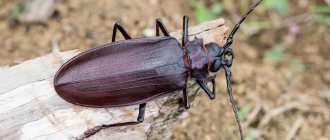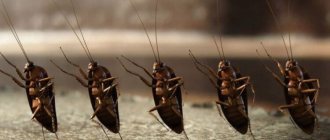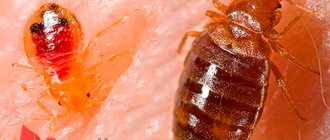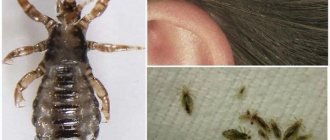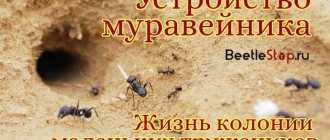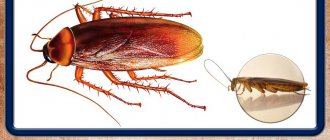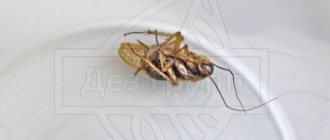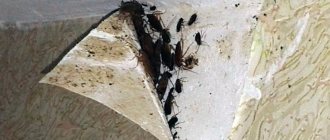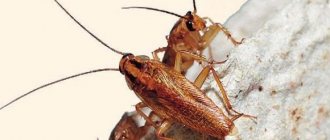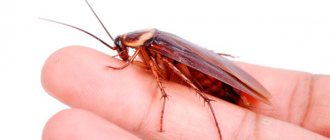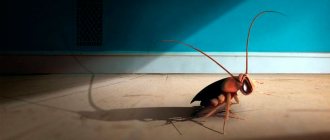Insects such as cockroaches have existed on earth for more than 300 million years, which has been proven by archaeological excavations. They are incredibly resistant to changes in climate and environmental conditions. They can survive in the cold, with little or no food, and live underwater or without oxygen for short periods of time. These insects are the most common in the world, among other types of household pests.
There are approximately 3,500 species of these insects. Most of them live outdoors and do not survive indoors. Only a small part consider houses to be their favorite habitat. It is difficult to find a place on the globe where these pests cannot be found. Due to the fact that they masterfully adapt to their environment, they are present in almost all parts of the world.
At the same time, all their ability to change makes them leaders in invulnerability. They easily get used to the type of pesticides that they were poisoned with earlier and do not react to it in the future. They can even do without a head.
In Russia there are only a few species: German, red, black. Such species mainly inhabit houses in Russia, America and Europe.
Cockroaches photo
The general appearance is familiar to everyone and is presented in the photo of cockroaches. They have an oval shape with a flat body, which allows them to fit into all types of cracks and crevices. The back looks like a kind of shield. With their long, spiny legs, they can quickly run long distances on almost any surface. Their paws have such properties that they can easily move along glass windows or walk on the ceiling. Different species differ in size and color, some of them can fly. The most common are German cockroaches. They are the ones who most often inhabit apartments, restaurants, hospitals, warehouses, offices, and so on. They have a brown color. A distinctive feature is two black stripes on the back of the body, near the head. Immature individuals, called nymphs, become darker in color. Being almost black, they have a light stripe in the middle of the back, which is a known marking of a juvenile. Significantly smaller in size than an adult.
An adult red cockroach is about 1.5 cm long. The adult male is golden brown in color and has a narrow body with wings extending beyond the tip of the abdomen. The female is dark chestnut in color, has a teardrop-shaped body, and her wings do not completely cover the abdominal cavity. Both sexes have distinctive horizontal yellow stripes. The nymph has two pale stripes that run horizontally across the entire body.
Animal world
The popular science encyclopedia “Animal World” is a treasure trove of entertaining and surprising facts. The book contains answers to many questions in various fields of knowledge, is distinguished by its original presentation of the material presented and a large number of interesting illustrations. The publication is intended for a wide range of readers.
Table of contents
The given introductory fragment of the book Animal World was provided by our book partner - the liters company.
How is a beetle different from a cockroach?
Even scientists do not know exactly how many beetles exist on the globe. They live everywhere - in the ground and on trees, in salt and fresh water, in mosses and silt. There are beetles of enormous size, such as the largest beetle in the world - the titan lumberjack, living in the Amazon forests. Its length reaches 18 cm. The Hercules beetle is slightly smaller - up to 16 cm. The Ussuri woodcutter and the African Goliath beetle are up to 10 cm long. And there are beetles that can only be seen with a magnifying glass. They come in different colors - black, blue, red, brown, yellow, etc.
There are hundreds of varieties of beetles, and they differ from each other not only in size and color, but also in their structure and way of life. For example, the rhinoceros beetle has an elongated, backward-curved horn on its head. Moreover, he can carry a load hundreds of times more than his own weight.
Water lovers and swimmers live in water, so their legs look like oars. All beetles live in different places and eat differently. Even among close relatives, some are carnivores, while others eat plants and bark. However, all these creatures, unlike each other, are united into one order - beetle-like insects.
In appearance, a cockroach can also be called a beetle, but it has nothing to do with them. Why was the cockroach not included in this large group?
If you carefully examine any of the beetles, no matter whether it flies or crawls, you can see four wings on all of them: two thin transparent ones that serve them for flight, and two hard ones that cover the lower wings and soft abdomen. When a beetle takes flight, its stiff upper wings rise and free its lower wings for flight. Flightless beetles also have similar wings, albeit weak and not intended for flight.
And cockroaches, no matter how much they resemble some beetles, have not two, but only one pair of wings. Therefore, they do not belong to the group of Coleoptera, as beetles with soft and hard wings are called.
Source
What are cockroaches afraid of?
These pests do not like strong odors such as vinegar or kerosene. Such dope will repel annoying insects. Also, ultrasonic devices have recently begun to appear on the market, but they have not yet fully proven themselves.
Since cockroaches move mainly at night, daylight or lamplight will stop them. But there is no point in spending money on electricity and being particularly happy; they will still find a way to profit. Finding tidbits in hard-to-reach places when cleaning.
The main thing cockroaches are afraid of is being hungry. If you maintain sanitary conditions, carry out regular wet cleaning, take out garbage in a timely manner, put food in containers, and do not leave dirty dishes and crumbs behind after eating, then cockroaches will have nothing to do.
But, if your room is loved by these insects, then getting rid of them will not be easy. After all, they easily adapt to new environmental conditions. And what scared them off the first time may not have an effect on them the next time. And they will not give up trying to move in with you again. The use of barrier protective equipment is necessary.
Useful materials
Read other articles about cockroaches:
- Interesting facts: what nicknames did people come up with for these insects; some myths about where the mustachios disappeared and what it could mean?
- Can cockroaches cause physical harm to humans, such as getting into the ear and nose?
- A detailed article about how to get rid of them, the most effective methods of control and prevention.
- There are now many treatments on the market against these parasites. Therefore, we wrote an article about how to choose a drug that is right for you, described the best products available today, and compiled a rating of insect repellent drug manufacturers.
- And of course, we couldn’t ignore all sorts of folk methods, in particular the most popular is boric acid.
- Well, if you yourself cannot cope with uninvited guests, then we recommend turning to professionals. They have modern fighting technologies and will save you from misfortune once and for all.
Below is a list of drugs that have proven themselves:
- Powders and dusts: FAS, Clean House.
- Crayons and pencils: Mashenka.
- Traps: Foresight, Combat.
- Very effective gels: Dohlox, Global.
- Aerosols: Raid, Raptor.
- Strong sprays: Executioner, Regent, Get, Cucaracha, Karbofos.
- Find out if electronic repellers help?
In Russia, not only the above-mentioned species are found, but the number of other species is small. Cockroaches at home are very unpleasant neighbors, so it is necessary to get rid of them in every possible way.
How do cockroaches reproduce?
Cockroaches have three stages of development: egg, nymph and adult. Each female produces 4-8 capsules during her life. The female carries the eggs in a special cocoon that looks like a capsule. It has an elongated long shape and a light brown tint. Inside the cocoon there are 2 rows of eggs. The female wears this capsule on the lower part of her body almost until the very moment of maturation.
Before hatching, the female lays a capsule by dropping it or sticking it to some surface. Most often, this happens in a secluded place where nymphs can easily find treats for themselves. It happens that the eggs mature while still on the female’s body and the capsule is opened.
Each capsule can contain from 30 to 50 eggs. When the maturation process is completed, the seam along the capsule on the upper part is broken through by the grown nymphs. After which, they immediately begin full-fledged life activities.
The population is dominated by young individuals, who are the vast majority in relation to adults.
The next stage is nymphs. These are small cockroaches that are no different in behavior from an adult. They also make constant forays in search of food.
Read also
How is an anion different from a cation?
How is an anion different from a cation? Anion and cation are ions, that is, electrically charged particles formed when electrons (or other charged particles) are lost or gained by atoms or groups of atoms (for example, molecules). The concept and term “ion” (translated from
How is a star different from a planet?
How is a star different from a planet? All the stars that we see in the night sky are actually suns like our big Sun. Only they are located very far away, much further than our star, so they seem to us like small stars. The most
How does oceanology differ from oceanography?
How does oceanology differ from oceanography? More than two-thirds of the surface of the planet on which we live is occupied by seas and oceans. This alone prompts us to think about how such a vast water shell of the Earth is structured, what impact it has on the habitat
How is a Japanese castle different from a European one?
How is a Japanese castle different from a European one? In Japan, historically, three types of castle structures were independent from each other: mountain (yamajiro), lowland (hirajiro) and mixed type castles (hirayamajiro). The mountain castle was a carefully fortified
How does a cyclone differ from an anticyclone?
How does a cyclone differ from an anticyclone? A cyclone is an atmospheric disturbance with low pressure in the center and vortex air movement. In the cyclone area, the weather is predominantly cloudy, with strong winds that blow counterclockwise in the Northern Hemisphere and
How is asepsis different from antiseptics?
How is asepsis different from antiseptics? Asepsis and antisepsis have the same goal - protecting wounds from infections - and are used only in combination with each other. The difference between them is that asepsis is a set of measures to combat microbes that have entered the wound, and
How is a hippopotamus different from a horse?
How is a hippopotamus different from a horse? All of you, obviously, have seen hippopotamuses in the zoo and can imagine what kind of animal they are: huge in size, low, with short thick legs. How can it be compared with a tall, graceful horse? And yet the word “hippopotamus”
How is gold different from “fool's gold”?
How is gold different from “fool's gold”? If you are a prospector looking for gold, then the answer to this question is as important to you as the difference between great wealth and immense poverty. Many prospectors have stumbled upon what they thought was gold,
What is the difference between a code and a cipher?
How does a code differ from a cipher? All ciphers are built according to similar laws. One letter or number replaces only one letter or number. "1" can mean "A" or "Z", but not the syllable "NA" or the whole word "England". Ciphers can be simple and complex. In simple ciphers, one character is always
How does a hypothesis differ from a theory?
How does a hypothesis differ from a theory? TARAS PASCHENKO Senior Lecturer, Faculty of Philosophy, National Research University Higher School of Economics A hypothesis is usually understood as a statement about which it is impossible to say for sure whether it is true or false. A hypothesis is an assumption that we make in an attempt
What is the difference between a loan and a loan?
What is the difference between a loan and a loan? It is necessary to distinguish credit operations from borrowed ones. During credit operations, new funds are created and a general increase in money in the monetary system occurs. A loan is just a change in the rights to manage money. The lender transfers his
How does a charter differ from a low-cost airline?
How does a charter differ from a low-cost airline? A charter airline carries passengers under an agreement with a tour operator. Charter flights take place outside the normal schedule and are carried out at the request of the customer. A charter flight is actually
Source
Do cockroaches bite?
Cockroaches are omnivores; they eat everything from plants to meat. In case of extreme infestation, where their number is very large, they can even bite a living person. Especially when food becomes limited. Therefore, the answer to the question do cockroaches bite is yes, they do. Although, this does not happen as often as one might think.
When it comes to biting, they are more likely to bite: Legs; Hands; Nails; Eyelashes. This does not mean that the cockroaches actually want to taste you. They don't do it intentionally. Food is the only thing they are looking for. Therefore, bites usually occur at night when people sleep with food debris around their hands or mouth. It is this leftover food that attracts them.
In most cases, cockroaches will not bite people if there are other food sources available, such as in trash cans or open food. When cockroach numbers are left unchecked, the population can outgrow normal food sources. In such a situation, they will be forced to obtain more food and eat things that they usually do not eat. Typically, pest control will begin before the population reaches these levels.
These ugly pests use a chewing motion that can cause painful bites that cause mild skin reactions in sensitive people.
Behavior
Cockroaches are predominantly nocturnal and exhibit complex social and group behavior . Recent studies have proven that cockroaches, to make it easier for other individuals to find them, deliberately leave a chemical trail to resources. Increased survivability is the main distinguishing feature of cockroaches. Going for a long time without food or water is not a significant problem. The ability of the cockroach body to withstand increased doses of radiation has been proven.
Beetles are also highly communicative. Most beetles make sounds of varying origins and different uses. Some types of beetles use glow. Poisonous beetles are very common. Male stag beetles, scarabs, often engage in fights over the possession of females or food resources.
And one more interesting fact. In some Asian countries, people consume adult cockroaches, whose meat has a very high protein content. And beetles are mostly eaten by larvae.
Fried cockroaches
The diversity of life is amazing. They are delighted with new information and new knowledge about the environment. Impressive facts help us rediscover the world we know, broaden our horizons, and provide the opportunity to make an exciting journey into the kingdom of nature.
AnimalsComment
How long does a cockroach live?
It takes 40-125 days to complete the nymph stage into a mature individual, under room conditions. Depending on environmental conditions and other factors. Adult German cockroaches can live up to one year, but most will die from various causes long before that time. Adult females live about 200 days.
To answer the question of how long a cockroach lives, you need to add up all the stages of its development. The total will be about 1.5 years, excluding the egg stage.
They are very stable and tenacious. If water is present, adults can live for about a month without food, but young nymphs will starve to death within 10 days. Without water and food, adults die in less than two weeks. At this time, cockroaches become very aggressive and begin to look for food even during abnormal periods such as daytime. They begin to move to other habitats in search of a better life.
A cockroach's body can survive even without its head for up to a week. This is because they breathe through small openings in body segments and have an open circulatory system. Since they do not need a head to breathe, these insects can survive without it for a short period of time. Eventually, the cockroach dies from dehydration because it will no longer be able to drink water.
Albinos
Most people are of the opinion that the albino cockroach is a separate species, but this is wrong. Insects acquire this color after molting . They are rarely seen because during this period the parasites hide in dark places until their color becomes normal.
Some individuals may acquire a white color due to exposure to chemical reagents. Many people believe that these insects become light-colored because they live in pitch darkness, but this opinion is incorrect. Scientists have proven that there is no separate albino species .
Where do cockroaches come from?
It is simply impossible to determine where the cockroaches come from. They move very quickly, are unnoticeable and constantly travel in search of new habitats.
They can get into your home for absolutely different reasons. You may unknowingly bring them with you after visiting some public place, be it a shopping center, cinema, cafe or others.
Since we live in apartment buildings, one infected apartment is enough for the whole house to suffer! They crawl through cracks and crevices, vents, sewer pipes, under doors, in common areas and stairwells, even along exterior walls through windows.
Your home is an ideal breeding ground for certain types of pests. With plenty of food, warmth, water and nesting sites, they can remain active all year round.
general description
Cockroaches are representatives of insects.
There are more than 4640 species of the cockroach superorder. These animals are among the most ancient, found in deposits of the Late Carboniferous and Paleozoic. Animals are heat-loving and moisture-loving. They are nocturnal and rarely go out during the day. In nature, they prefer to live under stones, in cracks in the ground, near roots and stumps. They feed on organic matter, including plants and dead animals.
Are cockroaches scary?
Creepy creaturesMore like vile
Cockroaches insects
Cockroaches are insects that can become pests in homes, schools, restaurants, hospitals, warehouses, offices, and almost any structure that has food preparation or storage areas. They contaminate food and cutlery, destroy fabrics and paper products, and impart stains and unpleasant odors to surfaces when they come into contact with them.
Such parasites can transmit bacteria that cause food poisoning. Also capable of transmitting pathogens, bacteria and hepatitis viruses. Participate in the spread of typhoid fever and dysentery. Internal cockroach infestations are an important source of allergens and asthma risk in some populations.
People are shocked when they find cockroaches in their homes and kitchens. Even if you maintain crystal cleanliness, you still will not be completely immune from the appearance of such neighbors.
Having seen one individual, there is a high probability that most of the population is simply hidden from view. So there is no need to delay destruction. First of all, carry out general cleaning, the main thing is not to forget about hard-to-reach places. If you do not see the special one yourself, you may stumble upon the waste products of these insects. In such cases, it is better not to delay until the breeding process develops into a larger disaster.
Calculator
Other household pests
Bugs, like all creatures, have their rightful place on this earth. But no one wants this place in our house. But, whatever one may say, insects make their way into our homes.
Dust mites
As annoying as it may be, there are dust mites in every home. Because they feed on dead skin cells, dust mites can thrive on any fuzzy surface that might contain tasty particles, be it carpet, upholstery, bedding or children's toys. While you can't completely eliminate mites, you can reduce their numbers by practicing regular cleaning practices.
Wash bedding in hot water at least once a week, and vacuum carpets and furniture regularly. To remove dust mites from stuffed animals or items you don't want to wash, place them in the freezer. Seal the items in a ziplock bag and place the bag in the freezer for at least 48 hours—dust mites will not survive a deep freeze.
Weevils
These insects typically enter your home from the grocery store. Adult weevils take up residence in rice and other grains to lay eggs, so you may not know you brought pests home until they hatch and are crawling all over your pantry!
The fastest cure for infection? Get rid of any unsealed dry foods, including flour, cornmeal, oats, rice, pasta and packaged foods that come in pre-opened bags. Then discard anything unpacked as soup mixes or gelatin. Even if weevils don't eat these foods, they may enter drawers to hide, only to emerge later to contaminate your food. After you've thrown away the infested food, clean out your pantry shelves and spray the entire area with insecticide. Once the liquid has time to dry, you can replenish the supply.
Several common types
There are a number of species that are most often found near people.
Prusak
A small red cockroach with a yellow-brown color. They run along horizontal and vertical surfaces, spread quickly and are completely unpretentious. They carry a lot of diseases and cause allergies. They enter homes through ventilation shafts, doors and in bags.
Black beetle
Long, glossy brown-black, unpretentious in the choice of food and place of residence. They do not move vertically, do not jump or fly. They love places with high humidity, prefer heating systems and water pipes.
American cockroach
Residents of most drains and sewers enter a person’s home only in case of extreme hunger. They are brownish-yellow, with long whiskers and a thin, oblong body.
Dietary preferences
Cockroaches are one of the most omnivorous animals. Living in nature, they feed on fruits, organic remains, carrion, and grass.
Insects living in the house are more unpretentious and eat everything that humans do:
- crumbs;
- flour;
- fruits;
- paper.
In conditions of lack of nutrition, they eat soap, clothing, book bindings and leather shoes. They attack people only in rare cases when there is no food at all.
Cockroaches: unpretentious and voracious.
Unusual facts
There are a number of unusual facts that may surprise ordinary people.
| Cause of death | Cockroaches can easily live without a head for more than a week. Their respiratory organs are located on the body, and they die of thirst. |
| Cockroaches are afraid of people | And this is a normal intense response to a threat. But, also, a person leaves oils on the animal’s body, which disrupts their vital functions. |
| They still bite | The strength is comparable to a mosquito bite. But after that you need to undergo treatment, because they can cause an infection. But they bite not out of malice, but out of hunger; they may only be tempted by the remnants of food that are stuck to their hands. |
| They change their running style | In a normal state and under stress, they run differently. When they escape from danger, they begin to rearrange their paws differently, taking turns in pairs. |
| They are still very useful | Chemicals from the brains of cockroaches are being used to develop cures for two deadly diseases, E. coli and Staphylococcus aureus. |
Benefits and harms
People are more accustomed to perceive cockroaches as pests. They get into houses, annoying residents. But there are both sides of the coin.
Benefits of animals
In nature, they eat plant debris, which speeds up the decomposition process. They are also part of the food chain and are present in the diet of many amphibians. Experiments are carried out on cockroaches and used in medicine.
Harm from cockroaches
More people are familiar with the harm caused by insects. They:
- carry diseases;
- are a source of infection;
- contaminate food;
- live in garbage chutes;
- damage valuables;
- aesthetically harmful.
Structure
The size of the animal depends on the species. The length of small individuals is 1 cm, and the largest ones reach 12 cm.
- They have a flat-oval body, a durable chitinous shell and strong jaws.
- The body is segmented, divided into several parts.
The structure of a cockroach.
- The two eyes do not have strong vision, and in some species they may be completely atrophied.
- The long antennae consist of a number of segments.
- The legs are strong, most often running.
- The wings are developed or partially shortened, in some species they are completely absent. But they are used more for planning; cockroaches do not fly very well.

